语言学第四章
语言学概论---第四章---语法

第四章语法一、名词解释1.语法2.客观存在的语法3.主观认识的语法4.历时语法和共时语法5.教学语法和面向信息处理的语法6.普遍语法和个别语法7.词法(形态学)和句法(造句法)8.组合规则和聚合规则9.核心语法(小语法)和外围语法(大语法)10.语法单位:语素、词、词组、句子、句组11.语法形式12.语法意义13.语法手段14.词法手段15.句法手段16.综合性语言17.分析性语言18.虚词、语类选择、语序19.语法范畴20.词法范畴、体词性范畴、谓词性范畴、句法范畴、类别范畴、关系范畴21.附加、屈折、异根、零形式22. 重音、轻读23.词类24.体词性词组、谓词性词组,向心词组、离心词组25.完全主谓句、不完全主谓句、非主谓句。
26.多重复句 27.句组二、简答和论述1.语法规则的性质和特点.2.请结合具体例子谈一谈语法和语音、语法和语汇、语法和修辞、语法和语境、语法和逻辑之间的关系。
3.语言学家研究语法,首先必须限定某个范围,确定自己的研究内容。
研究的内容不同,语法规则就会有所区别,这种区别最重要的有:4.历时语法与共时语法的区别:上面(1)5.教学语法与面向信息处理语法的区别:上面(2)6.普遍语法和个别语法的区别:上面(3)7.语法现象的分类(传统语法学、结构语法学和现代形式语法学分别怎样对语法现象进行划分?)8.词法规则、句法规则的区别:9.组合规则与聚合规则的关系。
10.为什么说每个语言成分都既处在组合关系中又处在聚合关系中?11.为什么说聚合规则是潜在的,组合规则是现实的?12.为什么说聚合规则和组合规则主要是指应用于词和句子的规则?13.现代形式语法学把语法分为核心语法和外围语法,为什么说这种语法分类是一种较新的观点,在理论和方法上都有重要的意义?14.语法单位之间的关系:15.怎样看待语素的语法地位?16.为什么说语法规律只有一种,而语法规则可以多种多样17.为什么说方言语法实际上是共时语法现象反映历时语法现象?18.为什么说形态丰富的语言中词法问题重要,而汉语中句法问题更重要?19.语法手段中的词法手段有哪些?20.语法手段中的句法手段有哪些?21.词的轻重音的作用:22.词的重叠的作用:23.语序的作用:24.语调的作用:25.类别范畴的表现形式:26.关系范畴的表现形式27.词缀和词尾有哪些不同?28.语法形式和语法意义有什么样的对应关系?29.词法范畴中的体词性范畴和谓词性范畴各包括哪些内容?30. 什么是句法范畴?请结合例子论述句法范畴所包括的内容.31.语法手段和语言类型有什么关系?32.不同语言的不同虚词形式:33.不同语言的不同语类选择形式.34.不同语言中相同的语法意义和不同的语法范畴.35.外语中的主句、小句、从句.36.英语的动词谓语句一般可以分为七种主要句型.37.汉语的动词谓语句分类和英语不同38.复杂结构单句、复谓结构单句与复句的区别39.为什么说词和句子是语法结构中最重要的两个单位?40.为什么说句子的意义和词的意义具有突出的地位?41.怎样看待语素的语法地位?42.划分词类可以有哪些不同的标准:43.各种语言词类划分结果的特点?44.为什么不同语言有不同的词类数量和类型?45.如何理解词组作为一种语法单位,它与词这种语法单位实际上是同质不同量的关系?46.词类和词组的聚合类的关系?47.汉语中比较重要的三种特殊词组:48.句子的类型49.什么叫复句,复句的判断标准是什么?50.直接组成成分分析法的定义及其原则:51.多重复句与句组的区别:52.要不要把句组作为一级语法单位?53.句组要不要作为语法单位?(请答出各种不同意见的根据所在)54.句组有哪些语法作用?55.句组的三种意义关系和三类衔接形式:参考答案一、名词解释1.语法:是语言中关于词的构成、变化和词构成词组和句子的规则。
语言学纲要笔记第四章语法

第四章语法一、语法的内涵和研究范围1、语言结构和使用的规则性2、客观的规则和对客观规则的抽象3、对“语法”的多层次理智(1)语法的词的构成、变化和用词造句的规则。
(客观的,一种语言只有一套)。
(2)对客观语言结构规则的描写、说明和解释。
实际指语法学。
(有主观性。
不同专家可能有不同的系统)。
陆俭明《现代汉语语法研究教程》P12-13:语法是一种语言中由小的音义结合体组合成大的音义结合体所依据的一套规则。
4、大语法和小语法(1)凡是能够体现为语言结构的规则性的部分都是语法。
(大语法)包括语音学、语义学、词法学(形态学)、句活学所研究的对象。
(2)只限于词和句子的构造规则。
(小语法,本书的理解)(3)有的甚至只指句子的构造规则(句法学)。
二、语法规则1、语言结构(1)结构成分:音义结合体,如语素、词、短语、句子。
(2)结构方式:成分与成分的组合,如:成绩好——好成绩。
虚素“们、看、了、呢”与别的成分组合时,永远不会出现在句道:“第、初、问”与别的成分组合时,永远不会出现在句末。
[分布]2、语法单位的内涵即语法系统的组成部分,凡是能在组合的是位置上被替换下来的组合成分单位,如短语、句子,都是合义结合的。
3、组合规则和聚合规则(1)组合规则:语法单位的组合起来的规则,链条,现实的,存在于话语中。
(2)聚合规则:语法单位的归类的规则,仓库,潜在地,存在于人脑中。
例如:小学生的句型练习:游戏中的语词龙(组合规则)及其后接的多种可能性(聚合规则)。
三、语法单位的层级性教材中从大单位到小单位,是解构式[分解]:应该从小单位到达单位讲,建构式[组合]。
(一)句子1、概念:语言交际的基本表述单位。
陆俭明《现代汉语语法研究教程》P21:是语言中前后有较大停顿、伴有一定句谓、表示相对完整意义有音义结合体,是最大的语法单位。
2、句型:按语气分:陈述句、疑问句、祈使句、感叹句。
张涤华等《汉语语法修辞词典》:[补充,不讲]句类:(1)句子的类型。
语言学概论(第四章)

二、组合规则
语素组合成词的规则
词的不同类型: 单纯词:由一个词根语素或一个词根语素加上屈折词缀构成的词 山、树、高、葡萄、窈窕、table、books、run 合成词:由两个或两个以上的构词语素组成的词 复合词:由词根语素按一定的规则组合起来构成的合成词 学习、黑板、司机、降低、football、railway、take-off 派生词:由词根语素和派生词缀组合起来构成的合成词 reaction、unjust、artist、musician、绿化、作者、木头
1)交际中能用来对话的片段,不管多么短,都算一个句子 “谁?”——“我。” 2)从语音形式上看,句子的最大特点是有一个完整的语调 3)句子可以根据不同的标准进行分类
根据句子的交际功能可分若干功能类型,简称句类
根据句子的结构特点,句子可以归纳为若干结构类型,简称句型
二、组合规则
语素组合成词的规则
语素的不同类别: 1)根据语素在构词中的不同作用可以把语素分为词根和词缀 词根:山、钱、家、说、炒、table、dance、fresh、blue、spy 词缀:老-、第-、-子、-者、-性、dis-、un-、co-、-ful、-er
词缀按与词根语素的位臵关系,可以分为前缀、中缀和后缀 词缀按功能可分为派生词缀和屈折词缀
3. 添加(插入)
小王骑走了自行车。→ 小王把自行车骑走了。 You know him. → Do you know him?
4. 替代
我请了老张,可老张不肯来。→ 我请了老张,可他不肯来。 Your bike is outside, is it?
四、变换
变换和句型
变换原则
小明打了他。→ 他被小明打了。 *他打了小明。 妈妈批评了小洪。→ *小洪被爸爸批评了。 妈妈批评了小洪。→ 妈妈批评了谁? → 谁被妈妈批评了? → 小洪被谁批评了? (1)老张用这个箱子装书。 (2)这个箱子老张装书。 (3)老张装书用这个箱子。 (4)装书老张用这个箱子。 (5)这个箱子老张用来装书。 (6)谁用这个箱子装书? (7)老张用什么装书?
语言学第四章要点
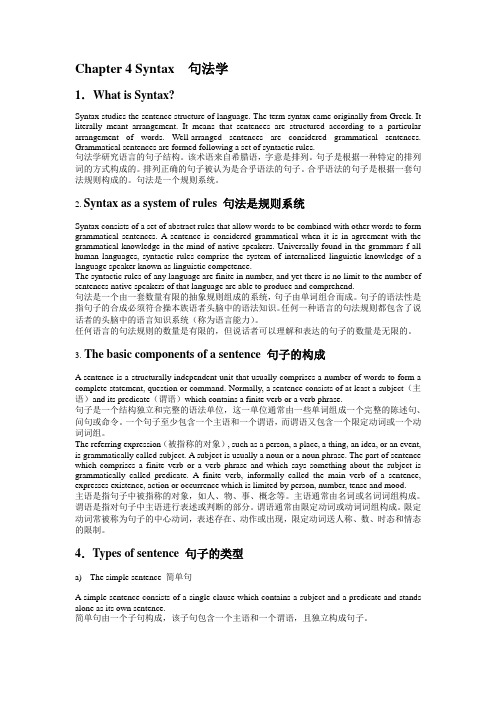
Chapter 4 Syntax 句法学1.W hat is Syntax?Syntax studies the sentence structure of language. The term syntax came originally from Greek. It literally meant arrangement. It means that sentences are structured according to a particular arrangement of words. Well-arranged sentences are considered grammatical sentences. Grammatical sentences are formed following a set of syntactic rules.句法学研究语言的句子结构。
该术语来自希腊语,字意是排列。
句子是根据一种特定的排列词的方式构成的。
排列正确的句子被认为是合乎语法的句子。
合乎语法的句子是根据一套句法规则构成的。
句法是一个规则系统。
2. Syntax as a system of rules 句法是规则系统Syntax consists of a set of abstract rules that allow words to be combined with other words to form grammatical sentences. A sentence is considered grammatical when it is in agreement with the grammatical knowledge in the mind of native speakers. Universally found in the grammars f all human languages, syntactic rules comprise the system of internalized linguistic knowledge of a language speaker known as linguistic competence.The syntactic rules of any language are finite in number, and yet there is no limit to the number of sentences native speakers of that language are able to produce and comprehend.句法是一个由一套数量有限的抽象规则组成的系统,句子由单词组合而成。
语言学第四章 ppt课件
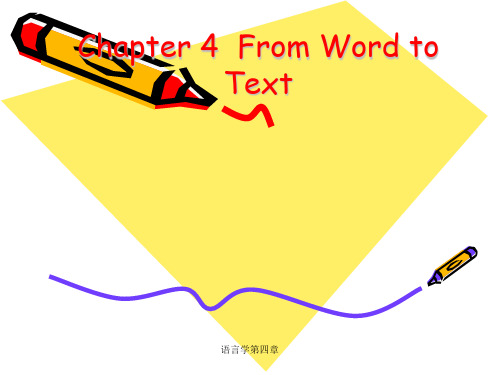
性关系
语言学第四章
• EX:
• The _______ smiles.
•
man
•
boy
•
girl
语言学第四章
4.1.2 Relation of Substitutability
• 替代关系 • The Relation of Substitutability
• , and Paradigmatic Relations (聚合关系) by Hjemslev(丹麦语言学家,哥本哈根学派的 创始人和主要理论家 ).To make it more understandable, they are called Vertical Relations(垂直关系) or Choice Relations.
语言学第四章
On the level of syntax, we distinguish for any construction in a language its external and internal properties.
The external syntax of a construction refers to the properties of the construction as a whole, that is to say, anything speakers know about the construction that is relevant to the larger syntactic contexts in which it is welcome.
语言学第四章
Any syntactic string of words ranging from sentences over phrasal structures to certain complex lexemes.(词的单位)
语言学概论第四章 语言的性质
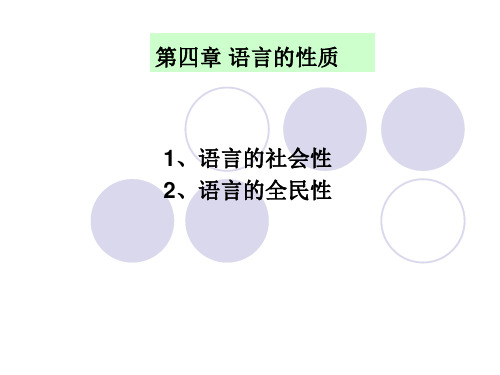
其中涉及心理、生理、物理等因素,但是没有社会因素作根底, 没有对社会约定的语言的共同理解,语言交际无法进行。
再看一个材料: 〔背景:20年代一个来华的德国牧师要给在他们家当女佣的
二、语言为全民使用。 三、语言为全民效劳。
思考:不同的阶级、阶层和集团对语言的 使用有一定影响,这是否与全民性矛盾?
需要注意:自言自语现象。 它是在个人范围内进行的,但是它并不
能否认语言交际的社会性。因为:
1、自言自语也是对语言的运用,只不过说者和 听者是一个人承担而已。
2、自言自语并不是交际的主要方面。
第二节 语言的全民性
一、语言为全民所创造。
全民包含两个方面:一个是历史上世世代代的人们,另 一方面是某个断代社会上的人们。
与植物有关的器官:种、苗、叶、枝、蘖 农具词汇:鉏、夷、斤、斸、耒、耜、耞、芟、镈、耨、 刈 关于农业生产活动场所的词:仓库、仓廪、田、田野、 沟、仓、渠、场、廪、畴、陆、阜、陵、墐、井、沟渎 与农业有关的动作行为的词来:坺、舂、耕、垦、耦、 耰、种
畜牧业方面的词汇只有6个:六畜、牧、刍、豢、牢、饩。 渔猎业方面的词汇有:搏、罟、网罟、罛、罶、罝、罗、罜、狩、蒐、 弋、毕、矠、阱、鄂。
我的祖母照片〕那时,祖母对照相机这东西非常恐惧,说是能 把小孩的灵魂摄去,因此千方百计谢绝了,这让德国人莫名其 妙,同时感到非常遗憾。〔?齐鲁晚报?〕
思考:在有的交际中尽管有时候对一些语言没有形成共同 的理解,但是交际仍然能够进行。这种个体性语言成分的存在 是否违背语言交际的社会性呢?
语言学概论第四章语法提纲
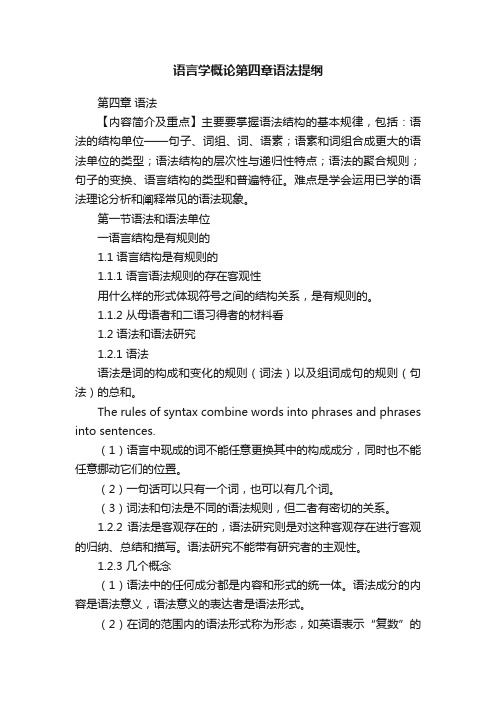
语言学概论第四章语法提纲第四章语法【内容简介及重点】主要要掌握语法结构的基本规律,包括:语法的结构单位——句子、词组、词、语素;语素和词组合成更大的语法单位的类型;语法结构的层次性与递归性特点;语法的聚合规则;句子的变换、语言结构的类型和普遍特征。
难点是学会运用已学的语法理论分析和阐释常见的语法现象。
第一节语法和语法单位一语言结构是有规则的1.1 语言结构是有规则的1.1.1 语言语法规则的存在客观性用什么样的形式体现符号之间的结构关系,是有规则的。
1.1.2 从母语者和二语习得者的材料看1.2 语法和语法研究1.2.1 语法语法是词的构成和变化的规则(词法)以及组词成句的规则(句法)的总和。
The rules of syntax combine words into phrases and phrases into sentences.(1)语言中现成的词不能任意更换其中的构成成分,同时也不能任意挪动它们的位置。
(2)一句话可以只有一个词,也可以有几个词。
(3)词法和句法是不同的语法规则,但二者有密切的关系。
1.2.2 语法是客观存在的,语法研究则是对这种客观存在进行客观的归纳、总结和描写。
语法研究不能带有研究者的主观性。
1.2.3 几个概念(1)语法中的任何成分都是内容和形式的统一体。
语法成分的内容是语法意义,语法意义的表达者是语法形式。
(2)在词的范围内的语法形式称为形态,如英语表示“复数”的“-s”就是一种形态。
词序表示词与词的关系,超出了词的范围,因此词序不是形态。
(3)把具有共同特点的语法形式概括起来就成为一种语法手段。
如附加语素和词序就是两种语法手段。
(4)语法最重要的特点是它的抽象性。
二语法的组合规则和聚合规则2.1 语法的两个基本规则2.1.1 组合规则语法单位互相连接起来构成更大的语言片断的规则叫做语法的组合规则。
2.1.2 聚合规则指语法单位的归类的规则。
语法上能够出现在相同句法位置上的词形成一个聚合,如果用来替换的不是从这个聚合里选出的词,句子也不能成立。
语言学概论课件 第四章 语法学

• 英语: • 名词:1、属格(加后缀-’s) • 2、通格(不加后缀) • 人称代词:主格、宾格、属格
一、语法范畴
• 4.时和体 • 时和体都是与动词相关的语法范畴,表示事件的时间关系和 过程状态。 • 时(tense)表示事件时间、参照时间、说话时间之间的时 序关系, • 一般分过去时、现在时和将来时。
一、语法范畴
• 5.态 • 态又称语态,是表示主语与动词的语义关系的语法范畴。一 般通过动词的形态变化来区分主动态和被动态。主动态表示 主语是动词的施事,即行为动作的主体,被动态表示主语是 动词的受事,即行为动作的对象。 • 英语就有主动态和被动态之分,主动态的动词形式不变,被 动态则用助动词be和动词的过去分词形式表示。
组合关系
聚合关系
递归性——指在语言单位的组合过程中,各种语法规 则可以反复地无限地使用。例如: 木头房子
一所木头房子
老师的一所木头房子 他的老师的一所木头房子 他的小学老师的一所木头房子 他的丈夫的小学老师的一所木头房子
• 鸦鹊鹊,肚下白,打下请老伯,老伯耳朵 聋;请裁缝,裁缝手脚慢;请老板,老板 心肠黑;请菩萨,菩萨心眼偏;请神仙, 神仙要猜拳;请和尚,和尚不睁眼……
二、语法形式和语法意义
• (一)语法形式 • 语法形式是反映词语的组合规则和语法类别的形式 标志,是表示语法意义的形式手段,又称语法手段 。 • 语法形式可分显性和隐性两种。显性语法形式可以 直接感知,主要包括语序、虚词、词缀、重叠以及 各种语音形式。 • 隐性语法形式不能直接感知,但可通过能否组合、 替换、扩展、变换等方式分析抽象出来。 • 有些语言主要通过不同的词形变化来体现名词和动 词的区别,但有些语言主要通过不同的组合功能来 体现。 “鸭蛋大”
语言学教程[第四章句法:从语词到篇章]山东大学期末考试知识点复习
![语言学教程[第四章句法:从语词到篇章]山东大学期末考试知识点复习](https://img.taocdn.com/s3/m/cad230e6ce2f0066f433220b.png)
第四章句法:从语词到篇章复习笔记I.句法1.定义句法就是研究语言不同成分组成句子的规则或句子结构成分之间的关系。
2.句法关系(1)位置关系位置关系或词序指的是一门语言中词语的排列顺序。
位置关系是任何人类语言中的基本句法关系,也是语言的句法可接受性和语义可理解性的要求。
(2)替代关系替代关系指在相同的句子结构中,语法上可以互相代替的词类或语词的集合,它还可指由多个词组成的词组,语法上代替特定集合中的单个语词。
(3)同现关系共现关系指不同词类的不同词汇集合允许另一个词类或集合的词出现构成一个句子或句子的某一特定成分。
II.传统语法学派传统语法认为句子是词的序列。
因此句子构造的研究涉及了对词的大量研究,例如词类是对词进行的分类,主语、谓语是对词的功能的描写等。
这些词类和功能有时叫做范畴。
1.数、性和格(1)数是用来分析词类的语法范畴,有单数、双数和复数等。
在英语中,数主要是名词的范畴,包括两种形式:单数和复数。
数还体现在代词和动词的屈折变化上。
(2)性指的是依照性别把名词分成不同类别的语法范畴。
性主要也是名词和代词的范畴。
在英语中,性的差别是自然的,由动物本身的生理性别决定。
然而准确地讲,性在这里指的是语法性,语法性主要有阴性、阳性和中性三种。
(3)格主要是名词的屈折范畴,它典型地标识着它们和句子其他部分之间的关系。
在英语中,代词一般有三种格。
即:主格、宾格和属格;名词只有两种格:普通格和属格。
2.时态与体时态与体是动词的两个重要范畴,传统语法没有对它们加以区分。
时态与体之间的区别在于:时态是指示性的,也就是说指明的时间与说话的时间相关;体则不是指示性的,指明的时间与说话的时间没有关系,却与叙述中描写或暗示的另一个事件的时间相关。
3.一致关系与支配关系一致关系是指在一个给定的语言结构中,词和短语之间利用至少它们中的一个所携带的屈折形式互相匹配的句法关系。
支配关系是指句法结构中某些词的形式受另一种其他类型词的控制。
语言学第四章课后答案

语言学第四章课后答案1、“桌子”,“书包”都属于名词,这体现了语法的什么性质()。
[单选题] *A.抽象性(正确答案)B.递归性C.系统性D.稳定性答案解析:“桌子”、“书包”等词语,虽然意思不同,但根据某种共同特点——大都能受数量词的修饰,就可以建立“名词”这个类:这就是词的用法对语法单位类别的抽象。
这体现了语法的抽象性。
2、语法规则的“系统性”是指()。
[单选题] *A.对语言的结构和成分进行类的概括B.相同规则可在一个结构里重复使用C.语法规则之间可以相互推导和解释(正确答案)D.语法规则的发展变化过程十分缓慢答案解析:所谓“系统”,指的是语法规则具有推导性和解释性。
3、“三思而后行”在今天读来依旧朗朗上口,体现了语法的什么性质()。
[单选题] *A.抽象性B.递归性C.系统性D.稳定性(正确答案)答案解析:“三思而后行”这句话产生在古代,现在依旧适用,体现语法的稳定性。
4、下列不属于共时语法的是()。
[单选题] *A.现代汉语语法B.先秦汉语语法C.汉语语法的演化(正确答案)D.近代汉语语法答案解析:共时语法指的是从某一时期存在的语法现象横向地静态地研究语法。
因此A、B、D选项都属于共时语法。
汉语语法的演化属于历时语法的体现。
5、以下关于“教学语法和信息语法”的内容说法有误的一项是()。
[单选题] *A.这是根据语法研究的用途区分的语法B.教学语法研究的结果面对的是人,或者说这种语法系统要充分考虑人的特点C.信息语法也叫“计算机语法”D.语法规则体系,方便计算机处理信息。
其特点是精确可靠,定义和规则具有可推导性和可开发性(正确答案)答案解析:教学语法和信息语法是根据语法研究的用途区分的语法。
教学语法研究的结果面对的是人,或者说这种语法系统要充分考虑人的特点;信息语法也叫“计算机语法”,其研究结果服务的是机器,即建立一套可以自动识别和操作的语法规则体系,方便计算机处理信息。
其特点是精确可靠,定义和规则具有可推导性和可验证性。
语言学概论第四章语法.
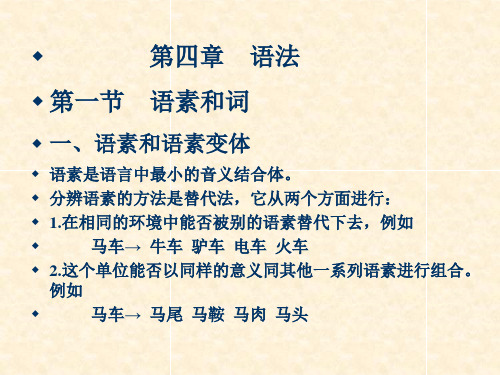
同一语素内略有差异的单位叫做语素变体 语素变体可分为语音变体和语义变体。 @语音变体: “一”的变体: (1)[i55][i51][i35](条件变体) (2)[i55]/[iau55] (自由变体:电话2115787、房号218) (条件变体:电报[iau] 、买菜[i]) 英语表示名词复数的s有下列变体: 1.[s]用在收音为清辅音的音节之后,如books[bukhs] 2 . [z] 用 在 收 音 为 浊 辅 音 和 元 音 的 音 节 之 后 , 如 dogs[d• gz];days[deiz]。 3 . [iz] 用 在 收 音 为 舌 叶 音 的 音 节 之 后 , 如 benches[bentSiz]
语素的分类: 根据语素在词中的作用,可以分为词根语 素和附加语素两种。 词的词汇意义的主要表达者称为词根语素, 是词的核心部分; 粘附于词根之上,表示附加意义的语素称 为附加语素,其中只表示语法意义的附加 语素又叫词尾,其他叫词缀。 例如在英语“teachers”这个词中,“teach” 是词根,“-er”是词缀,“-s”是词尾。
词缀又根据在词中的位置,分为前缀、后 缀和中缀。 根据语素能否独立成词可以分为成词语素 和不成词语素。 成词语素是能够独立成词,又能和别的语 素组合成词的语素。 汉语:人 天 地 大 小 学 不成词语素是不能独立成词,只能与别的 语素组合成词的语素。 汉和词的构成 词的结构类型指的是构成词的语素之间的种种 关系形成的类型,可以 分为单纯词和合成词两 大类型。 单纯词是由一个语素构成的词。 汉语 “人”、“蜻蜓”、“沙发” 英语 “man” 、“do”、 “red” 合成词是由两个或两个以上语素构成的词,其 中构成语素都是词根的叫做复合词,构成语素 有词根也有词缀的叫派生词。
语言学概论 第四章

A、表复数或“逐个”的意思。如马来语名词重叠 表复数,汉语中名词或量词表重叠表“逐个”的 意思。如“人/人人”“个/个个”等。 B、表短时和尝试的意思。如汉语中的“想/想 想”“体验/体验体验”等。 C、表程度增加的意思。如“雪白雪白”等。
5、句法手段
(1)虚词是通过使用虚词来表示一定语法意义的形式。 语言中凡是没有词汇意义只有语法意义的词就是虚 词。虚词可分为辅助词和功能词两小类。
2、在这三种分类标准中,功能分布的标准最具普 遍性,而且是反映词类聚合关系本质的特征,是 词类的本质属性。因为仅从词的意义标准来划分 词类,有些词汇意义相同或相近的词却分属不同 的词类的现象就不能得到解释。而以形态标准来 区分词类,对那些形态较发达的语言比较可行, 但在那些缺少形态或根本没有形态变化的语言面 前又无能为力了。因此分布标准最可行,只是在 具体区别词类时,形态和意义也可以作为参考。
如:“一张动物园”,看起来是量词误用,其 实是“我要买一张去动物园的票”这句话的成分 省略现象。 初中,某数学老师讲方程式变换,在讲台上 袖子一挽大声喝道:同学们注意!我要变形 了!……
5、语法和逻辑
逻辑是语言表现内容的规律,语法是语言表 达形式的规律,二者的关系非常紧密。逻辑对语 法的影响主要表现为对语言成分之间搭配关系的 制约。从基本要求看,一般人们说话不但要合语 法,也要合逻辑。个别不合逻辑的,只要大家都 这么说,都懂得是什么意思,就不能完全用逻辑 来苛求了。
3、词类划分结果的特点:
(1)各种语言都有一些共同词类,也有一些特殊的 词类。 (2)各种语言的主要词类都可以根据某种共性往上 归大类,也可以根据某种个性往下分小类。 (3)各种语言中都有-些词是典型的某类词,也有一 些词则可能是边缘的或跨类的词。
语言学概论第四章

(二)语义场的系统性 语义场最重要的特点是它的系统性。一个语义场 内包含若干个词语(义项),在意义领域恒定或 封闭的状态下,一个词义占据的地盘大了,其他 词义的地盘势必就会缩小;一个词义占据的地盘 小了,其他词义的地盘势必就会扩大。在这种情 况下,系统中某个词语的意义会受到系统中其他 词语的制约,系统中某个词义的变化或词语数量 的增减,会导致意义领域的重新划分和分配,从 而引起系统中其他词义的变化。
第三节 词义的聚合
一、语义场 (一)“语义场”是词义系统性的重要表现。词 义有一定的系统性。一个词语的意义(义项)同 邻近的其他词义可以建立起各种关联,从而处于 互相依存、互相规定、互相制约的关系之中。 “语义场”是指具有共同类属义素的词语(义项) 构成的聚合体。类属义素是指反映事物所属类别 的语义特征。比如“钢笔、铅笔、圆珠笔……”的 类属义素都是“书写工具”,它们就构成一个语 义场。“车、船、飞机”的类属义素都是“交通 工具”,它们也构成一个语义场。
义素分析法可以清楚、简洁地说明词义的 结构,便于比较词义之间的异同。并且义 素分析法可以使语义的描写形式化,对包 括机器翻译、人机对话等在内的自然语言 的计算机处理具有重要意义。
横排结构式: 哥哥[+同胞+男性+年长] 弟弟[+同胞+男性 -年长] 姐姐[+同胞 -男性+年长] 妹妹[+同胞 -男性 -年长]
(三)语义场的层次性 事物本身的分类是有层次的,因而反映事物类别 的语义场之间也就形成了有层次的结构。若干较 小的语义场可以集合成较大的语义场,若干较大 的语义场可以集合成更大的语义场。
车 汽车 火车 卡车、轿车、吉普车 交通工具 船 飞机 自行车
二、同义词与反义词 (一)同义词 同义词是意义相同或相近的一组词。 意义完全相同的一组词称为“等义词”。如:维 生素与维他命,演讲和讲演,番茄与西红柿。 基本意义相同而有细微差别的一组词称为“近义 词”。近义词之间的差别可以表现在词的理性意 义之上,如:天气与气候,才能和才华。也可以 表现在非理性意义即附加色彩上,如结果与成果, 聪明与聪颖。
语言学第4章
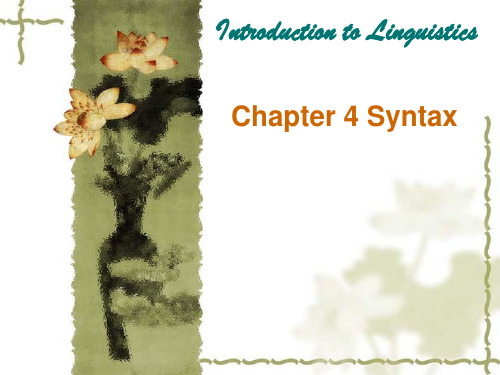
4.4.1 Structural analysis
One type of descriptive approach is called structural analysis. Its main objective is to study the distribution of linguistic forms in a language.
4.2 Word Classes
unacceptable a. Cries fear the the of hunter blackbirds the. b. The hunter fears the cries of the blackbirds. acceptable
What we are here concerned with is the grammatical structure.
The method involves the use of “test-frames”. car, radio, child, etc. (4) The _____ makes a lot of noise. All these linguistic forms fit in the same testframe, they are likely to belong to the same grammatical category, i.e. noun. noun
However, we should note that it does not mean that these prescriptive rules cannot be broken. In spoken English, for example, split infinitives as to boldly go instead of to go boldly or boldly to go are used sometimes.
语言学概论--第四章 词汇

注
意
一定要把“词”和“词汇” 这两个概念区分开来。词汇是 词和固定短语的“总汇”,不 是单指个别的词语,而是指词 的集合。有人从网上对1999年 到2002年共四年的《人民日报》 中的“词汇”一词的使用情况 进行了统计,共检索出包含 “词汇”的用例172例,使用规 范的例句只有45个。
应当指出的是,“词汇”作为 语言学专业术语,其内涵也不是单 一的。它可以指一种语言中所有词 和固定短语的总和,如“汉语词 汇”、“俄语词汇”等;它可以指 词汇的下位类型,如“方言词汇”、 “科技词汇”、 “基本词汇”、 “一般词汇”、“《儿女英雄传》 的词汇”、“少儿词汇”、“鲁迅 的词汇”、“莎士比亚的词汇”等。 但不论其内涵如何,词汇只能 指许多词语的总和,不能单指一个 词。
词 汇 研 究 的 重 要 性
词的正确使用是准确表达思想 的前提之一,如果使用不当,就不能正 确地表达思想感情. 高尔基曾说: “作为一种力量,而 起作用的真正的语言美,是由词汇的 确切、鲜明和响亮动听而创造出来 的。而词汇的确切、鲜明和响亮动 听则构成了书的图景、性质和思想。 广泛地熟悉我们丰富词汇的一切词 藻,对于一个作家-----„艺术家’来说 是有必要的,而且善于从中挑选最确 切、鲜明有力的词儿,也是必要的。”
四、 词 汇 的 分 类
一种语言中的词汇是相当 丰富的。为了研究的方便,可 根据不同的标准对词汇进行分 类。 (一) 基本词汇和一般词汇 根据词在词汇体系中的地 位和作用划分的 1.基本词汇 词汇中最稳固的核心部分, 它是千百年来被人们长期使用 着的那部分词,是构成新词的 基础。
基本词汇的三个特点: A 全民常用性 B 历史稳定性 C 构词的能产性 2 . 一般词汇 词汇中除去基本词汇之外的 所有成员。
语言学概论:第四章-语法
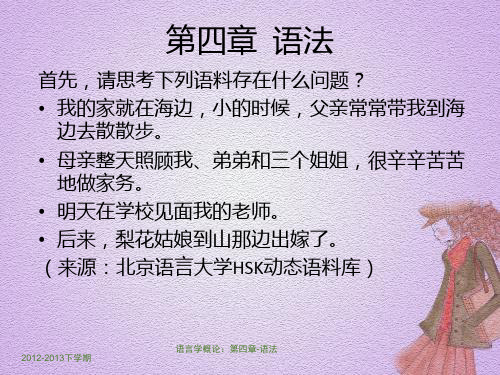
(一)语法形式
1、语序:词语排列的先后顺序。 汉语:我们理解——理解我们
衣服干净——干净衣服 紧握——握紧
俄语:他喜欢数学 • Он любит математика • Он математика любит • Mатематика oн любит • Mатематика любит oн • любит oн математика • любит математика oн
冬天
中性
2012-2013下学期
钢笔
房子`
语言学概论:第四章-语法
2、数:是词的语法形式所表示的事物或现象的量的 特征。主要是名词和代词所有的语法范畴。
景颇语人称代词的数 单数 [ŋai33]我 [naŋ33]你 [kj‘i33]他 双数 [an55]我俩 [nan55]你俩 [k‘an55]他俩 复数 [an55 t‘e 33] 我们 [nan55 t‘e 33]你们 [k‘an55 t‘e 33]他们
开白和布关——
语言学概论:第四章-语法
白色的布
计算机汉语分词的难点
交集型歧义字段问题”(词的边界问题)
(1)这样,才能干警务工作。 (2)公路局处理解放大道路面积水问题。
2012-2013下学期
语言学概论:第四章-语法
2012-2013下学期
语言学概论:第四章-语法
第三节 句法
一、短语(词组)
(三)语素的类型
(1)根据语素构成词的能力 • 成词语素: 汉语:山、钱、说、炒、高…… 英语:table,house,dance,kill…… • 不成词语素: 汉语:警、威、究、协、净…… 英语:unfair,reader,useful
2012-2013下学期
语言学第四章试题及答案

语言学第四章试题及答案一、选择题(每题2分,共20分)1. 下列哪个选项不是语言的社会功能?A. 信息传递B. 表达情感C. 娱乐消遣D. 思维工具答案:C2. 语言的任意性是指:A. 语言符号与其所指对象之间没有必然联系B. 语言符号与其所指对象之间有必然联系C. 语言符号的形式与其意义之间没有必然联系D. 语言符号的形式与其意义之间有必然联系答案:A3. 下列哪个选项是语言的组合规则?A. 语音规则B. 语义规则C. 语法规则D. 语用规则答案:C4. 语言的层级性是指:A. 语言的语音、词汇、语法等不同层次B. 语言的语音、词汇、语义等不同层次C. 语言的词汇、语法、语用等不同层次D. 语言的语音、语义、语用等不同层次答案:A5. 下列哪个选项是语言的变异性?A. 语言的稳定性B. 语言的保守性C. 语言的创新性D. 语言的一致性答案:C6. 语言的交际功能主要体现在:A. 个人表达B. 社会互动C. 个人思考D. 社会规范答案:B7. 语言的规范化是指:A. 语言的标准化B. 语言的多样化C. 语言的统一化D. 语言的个性化答案:A8. 语言的符号性是指:A. 语言符号与其所指对象之间有必然联系B. 语言符号与其所指对象之间没有必然联系C. 语言符号的形式与其意义之间有必然联系D. 语言符号的形式与其意义之间没有必然联系答案:B9. 语言的动态性主要体现在:A. 语言的稳定性B. 语言的保守性C. 语言的创新性D. 语言的一致性答案:C10. 下列哪个选项不是语言的语用规则?A. 语境规则B. 语义规则C. 交际规则D. 语用规则答案:B二、填空题(每题2分,共20分)1. 语言的______性是指语言符号与其所指对象之间没有必然联系。
答案:任意2. 语言的______性是指语言符号的形式与其意义之间没有必然联系。
答案:组合3. 语言的______性是指语言的语音、词汇、语法等不同层次。
语言学概论第四章语义笔记

语义一、语义的内容和性质(一)意义与语义:意义(价值、语义)例如:1、改革开放具有深远的意义;2、粮食对于一个农民的意义;3、这个词在这句话的意义是什么;(语义)所以,“意义”和“语义”是两个不同的概念,它们所指的对象是不一样的,它们不是同义词,而是上下位概念。
而“语义”一项在语言意义这个范畴内也有几层意思;语言单位的意义:语义:可推行的交际单位的意义:不可推行的“举烛”事件使燕国强大(?书燕说)语义:是人们对“三个世界”(客观世界、主观世界、语言世界)(二)语义的内容(主要类型)1、理性意义和附加意义(认知角度)①理性意义:是人们对客观世界以及人的精神世界中的现象的理性认识在语言中的反映。
如:妇女:【 + 人】【 + 成年】生命:【 + 生命】【 + 停止】理性意义是抽象的,概括的,是语义的核心内容。
②附加意义:是附着在理性意义上的反映语言使用者的心理文化等特征意义。
A、感情色彩和语体色彩感情色彩:表说话者对所谈对象的感情或态度,有褒义、贬义和中性三种。
如:“成功”和“得逞”“成果、后果、结果”语体色彩: 表词语所用的社会坏境通常有口语语体和书面语体。
如:书面语体,母亲;口语语体,妈、娘;一般语体,妈妈;B、联想色彩a、形象联想:指词的理性意义所引起的人们对现实中某种形象的联想。
b、意义联想:由于多义词的几个义项或同音词的几个意义相互作用而产生的联想。
(比如说“元音和原因”同音)c、文化联想:是由于人们的文化背景、社会观念的作用而产生的联想。
(如:中国人和英美人谈到对狗的看法)2、词汇意义和语法意义(语言系统角度)词汇意义:词的语言形式能够表达的全部内容,包括理性意义和附加意义,从客观事物和现象中抽象出来的,与人的认知能力有关。
语法意义:语法形式表达的意义。
从语素、词、短语中、句子等语法单位中抽象出来的,用语言的特点有关。
(“他学习我”和“我学习他”词汇意义不变,构成词汇相同)3、语言意义和言语意义(语言状态角度上):语言意义:是词在语言系统中固有的意义,它是抽象的概括的是全社会共同理解的。
- 1、下载文档前请自行甄别文档内容的完整性,平台不提供额外的编辑、内容补充、找答案等附加服务。
- 2、"仅部分预览"的文档,不可在线预览部分如存在完整性等问题,可反馈申请退款(可完整预览的文档不适用该条件!)。
- 3、如文档侵犯您的权益,请联系客服反馈,我们会尽快为您处理(人工客服工作时间:9:00-18:30)。
• Exocentric construction: – the basic sentence, – the prepositional phrase, – the predicate (verb + object) construction – the connective (be + complement) construction.
• He kicked the ball. (Neither constituent stands for the verb-object sequence.) • John seemed angry. (After division, the connective construction no longer exists.)
Tree diagram
S
NP Det N V VP NP
Det N
The boy ate the apple
Bracketing
• ((The) ( boy)) ( (ate) ((the) (apple))). • [S [NP [Det The] [N girl] ] [VP [V ate] [NP [Det the] [N apple]]]]
4.2.4 Coordination and Subordination
• Endocentric constructions fall into two main types, depending on the relation between constituents.
Chapter 4 From Word to Text
Outline
4.1 Syntactic Relations 4.2 Grammatical Construction and Its Constituents 4.3 Syntactic Function 4.4 Category 4.5 Phrase, Clause and Sentence 4.6 Recursiveness 4.7 Beyond the Sentence
– The
strong man tallest boy pretty girl
smiles.
yesterday. last week. the day before.
– He went there
• This is also called Associative Relations by Saussure, and Paradigmatic Relations by Hjemslev.
4.2.3 Endocentric and Exocentric Constructions
• Endocentric construction is one whose distribution is functionally equivalent to that of one or more of its constituents, i.e., a word or a group of words, which serves as a definable centre or head. – E.g. noun phrases, verb phrases & adjective phrases
• The boy smiled. (Neither constituent can substitute for the sentence structure as a whole.)
• He hid behind the door. (Neither constituent can function as an adverbial.)
The girl ate the apple
Syntactic Categories
Word-level
N=noun A=adjective V=verb P=preposition Det=determiner Adv=adverb Conj=conjunction
Phrasal
NP=noun phrase AP=adjective phrase VP=verb phrase PP=preposition phrase S=sentence or clause
– the girl (NP)
– ate the apple (VP)
– the girl ate the apple (S)
• Immediate Constituent Analysis
( IC Analysis)
The analysis of a sentence in terms of its immediate constituents– word groups (or phrases), which are in turn analyzed into the immediate constituents of their own, and the process goes on until the ultimate constituents are reached.
• Positional relation, or WORD ORDER, refers to the sequential arrangement of words in a language. If the words in a sentence fail to occur in a fixed order required by the convention of a language?
– To make it more understandable, they are called Vertical Relations or Choice Relations.
4.1.3 Relation of Co-occurrence
• It means that words of different sets of clauses may permit, or require, the occurrence of a word of another set or class to form a sentence or a particular part of a sentence.
– an apple (determiner +noun→ NP)
– ate an apple (verb + NP → VP)
– Mary ate an apple (noun + VP → S)
4.2.2 Immediate Constituents
• Constituent is a part of a larger linguistic unit. Several constituents together form a cboy kicked the ball.
– *Boy the ball kicked the – *The ball kicked the boy
• The teacher saw the students. • The students saw the teacher.
• Positional relations are a manifestation of one aspect of Syntagmatic Relations observed by F. de Saussure. – They are also called Horizontal Relations or simply Chain Relations.
4.1.1 Positional Relation
• For language to fulfill its communicative function, it must have a way to mark the grammatical roles of the various phrases that can occur in a clause. • The boy kicked the ball. NP1 NP2 Subject Object
• Syntax is the study of the rules governing the ways different constituents are combined to form sentences in a language, or the study of the interrelationships between elements in sentence structures.
– The ______ smiles. man boy girl
• It also refers to groups of more than one word which may be jointly substitutable grammatically for a single word of a particular set.
Three basic ways to • Word order
Genetic relatedness, i.e. some languages share a classify languages: common ancestor language, e.g. English and German
• Relations of co-occurrence partly belong to syntagmatic relations, partly to paradigmatic relations.
4.2 Grammatical Construction and Its Constituents
4.2.1 Grammatical Construction • Grammatical construction (or construct) refers to any syntactic construct which is assigned one or more conventional functions in a language, together with whatever is linguistically conventionalized about its contribution to the meaning or use the construct contains.
